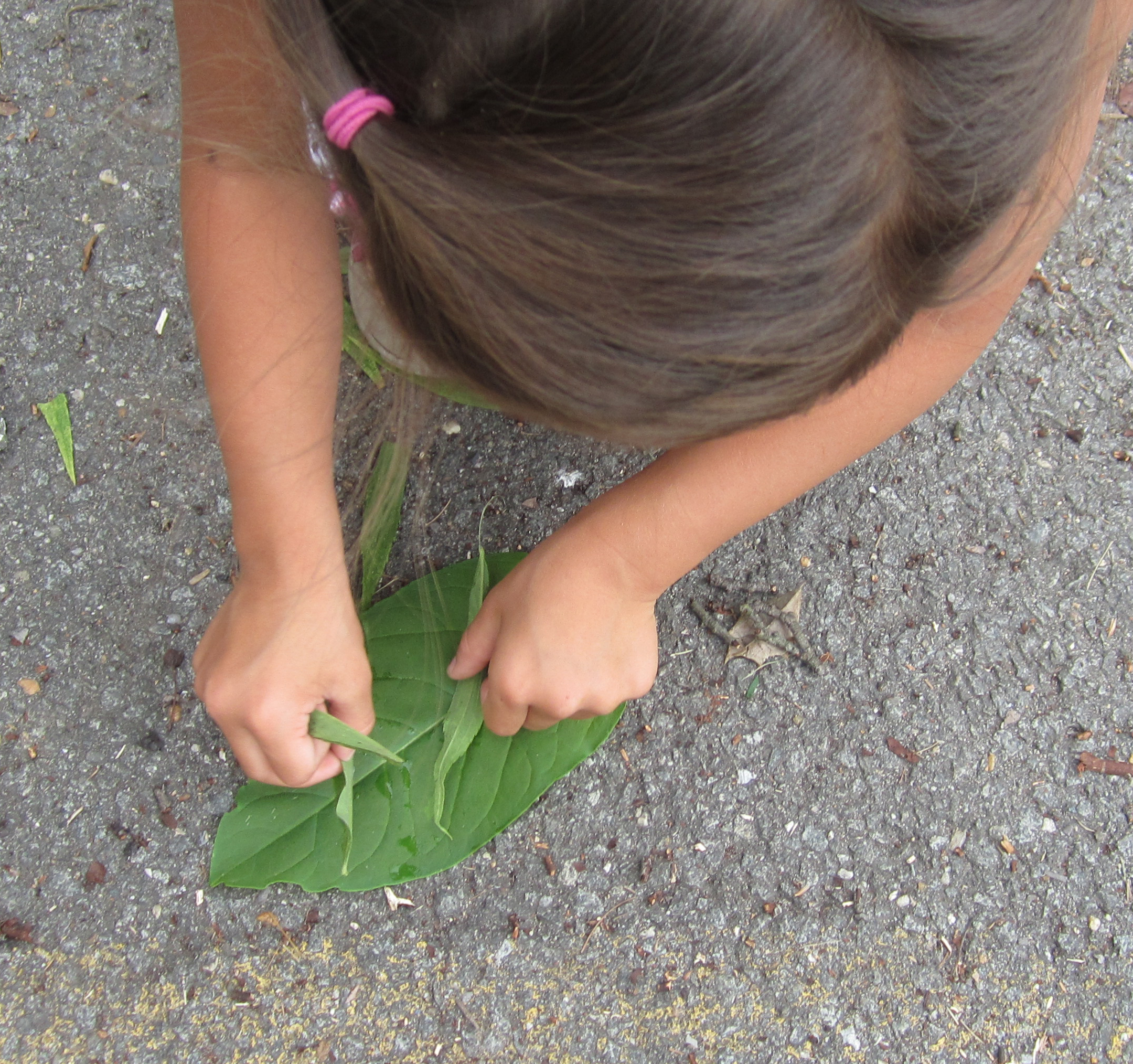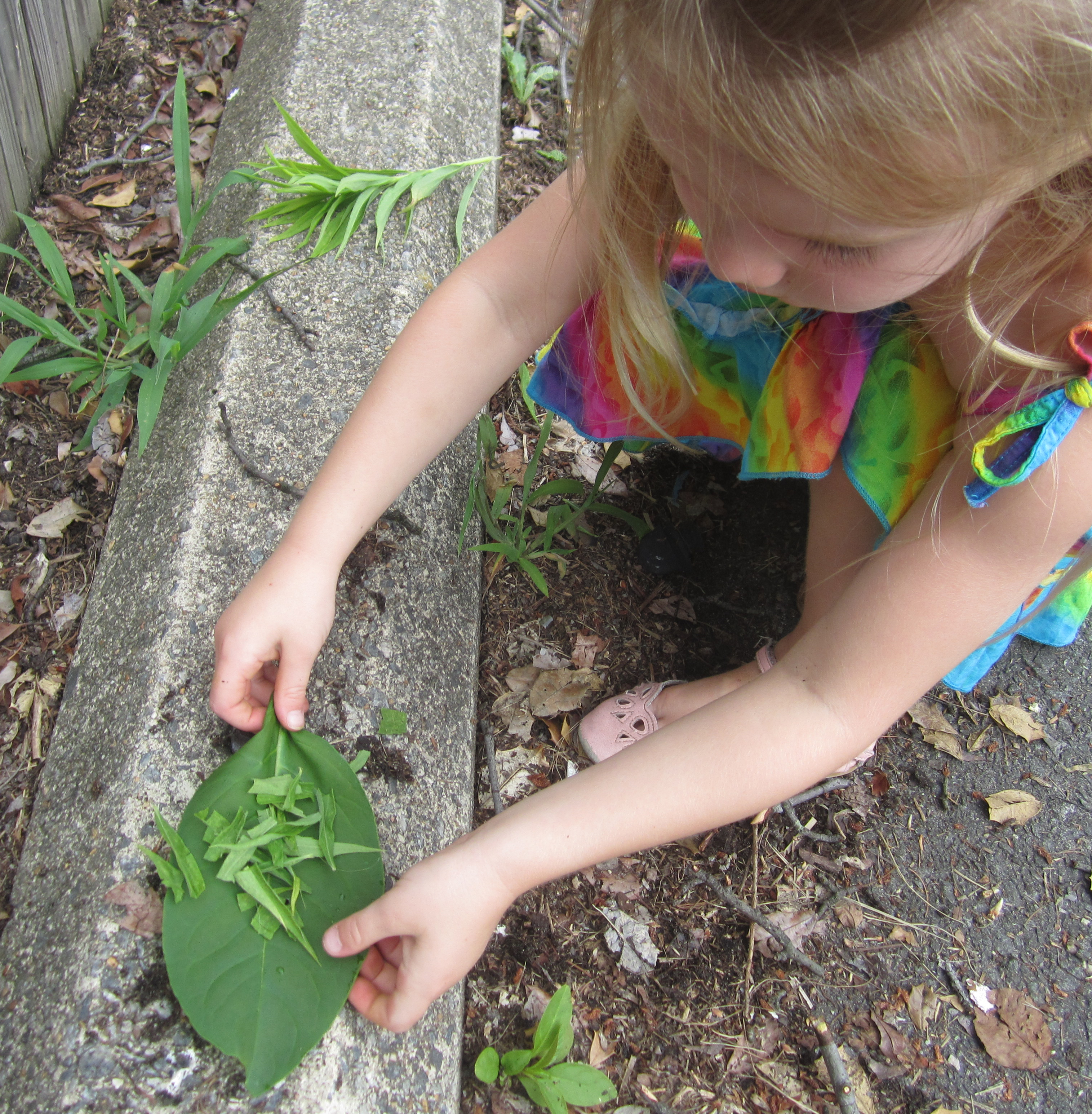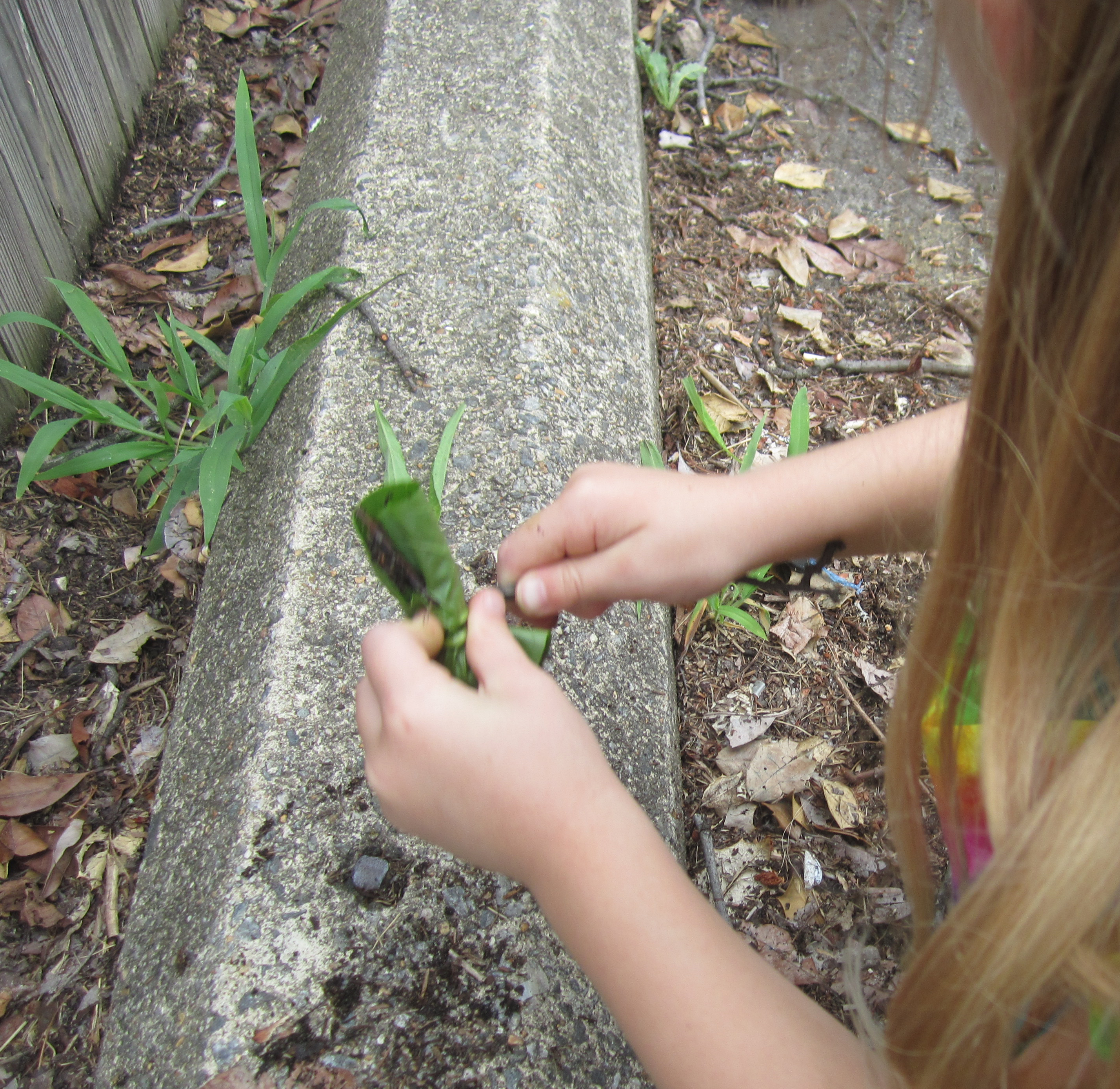Joys of summer
By Peggy Ashbrook
Posted on 2014-06-22
Children play year-round but some media for play is more easily used in summer. Some recent play that I’ve observed:
Observing the motion of wood chip mulch as it is shaken back and forth on a spring rider.


Using tools to move water and observe its flow.


Making a tunnel in the sand (damp but not frozen like it often is in winter!).

“Cooking” with leaves and sticks found at the end of a parking lot. One child asked, “Is this a useful plant?” We talked about a definition of weeds and how she wanted to use the plant.
Documenting where the shadow is in the morning, and planning to re-visit the outline in the afternoon.

I hope to have this much fun learning all summer!
Science of Golf: potential and kinetic energy
By Judy Elgin Jensen
Posted on 2014-06-20
 For the first time ever, the women are playing their U.S. Open on the same course as the men. Watch 2010 U.S. Women’s Open champ Paula Creamer in Science of Golf: Potential and Kinetic Energy to see the energy transformations they’ll use to power the ball down the tricky course. Creamer says, “You’re so much in control of what you do…” so even though most women don’t drive the ball as far as the men, look for the competition to be every bit as fierce.
For the first time ever, the women are playing their U.S. Open on the same course as the men. Watch 2010 U.S. Women’s Open champ Paula Creamer in Science of Golf: Potential and Kinetic Energy to see the energy transformations they’ll use to power the ball down the tricky course. Creamer says, “You’re so much in control of what you do…” so even though most women don’t drive the ball as far as the men, look for the competition to be every bit as fierce.
This video is one of ten to further your STEM efforts, brought to you by the partnership of NBC Learn, the United States Golf Association (USGA), Chevron, and NSTA. The NSTA-developed lesson plans for these latest additions all focus on engineering design practices—in this case building a better golf ball or golf club face. If your students don’t have a lot of experience with golf equipment, head over to the nearest garage sale or your local used sporting goods resale shop. Used clubs and balls can be had for very low cost. Or check in with a nearby golf course. People leave behind clubs and balls on the course all the time and they might just have some unclaimed ones to give you.
Find the series—available cost-free—on www.NBCLearn.com. You can also use the links below to access the video or grab the lesson plans (in Word format for easy editing). We look forward to hearing from you about how you expect to use the videos as well as how the lesson plan works out in practice with your students. Once you try it out, please leave comments below each posting!
Video
SOG: Potential and Kinetic Energy features energy transformations and Creamer’s technique, which allows her to get more energy into her swing.
STEM Lesson Plan—Adaptable for Grades 7–12
SOG: Potential and Kinetic Energy guides students in the design of a golf ball covering or club face that optimizes the transfer of energy. It also provides ideas for STEM exploration plus strategies to support students in their own quest for answers as well as a more focused approach that helps all students participate in hands-on inquiry.
Image of Paula Creamer courtesy of Secret in the Dirt.
You can use the following form to e-mail us edited versions of the lesson plans: [contact-form 2 “ChemNow]
 For the first time ever, the women are playing their U.S. Open on the same course as the men. Watch 2010 U.S. Women’s Open champ Paula Creamer in Science of Golf: Potential and Kinetic Energy to see the energy transformations they’ll use to power the ball down the tricky course.
For the first time ever, the women are playing their U.S. Open on the same course as the men. Watch 2010 U.S. Women’s Open champ Paula Creamer in Science of Golf: Potential and Kinetic Energy to see the energy transformations they’ll use to power the ball down the tricky course.
Five Ways to Read Science & Children in 15 Minutes
By Carole Hayward
Posted on 2014-06-19


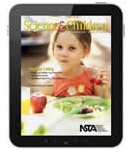 Science and Children editor Linda Froschauer recently wrote about how elementary school teachers must “intertwine science disciplines and provide many types of disciplinary core ideas within a single topic of study.” Each issue of Science and Children aims to provide timesaving resources that alleviate stress, connect to national standards, and enhance overall student learning. Here are five accessible ways to glean the most important information from your journal subscription in just 15 minutes.
Science and Children editor Linda Froschauer recently wrote about how elementary school teachers must “intertwine science disciplines and provide many types of disciplinary core ideas within a single topic of study.” Each issue of Science and Children aims to provide timesaving resources that alleviate stress, connect to national standards, and enhance overall student learning. Here are five accessible ways to glean the most important information from your journal subscription in just 15 minutes.
- Go digital.
Get your digital edition so you flip through the issue from anywhere: the car wash line, the salon, or even in front of a campfire. (You never know when science inspiration will strike!) But you can also stay in touch with the journal on social media by following Facebook and through the NSTA Twitter feed. Get the latest updates to share with other educators and save for later.
- Boost basic knowledge with Science 101.
Elementary educators are expected to have foundational knowledge in many subjects, but all teachers need a refresher from time to time. Use this column to boost your science knowledge on topics as diverse as friction, sound, and chemistry from Bill Robertson, the author of NSTA Press® best-selling series Stop Faking It! Finally Understanding Science So You Can Teach It.
- Peek into a primary classroom with The Early Years column.
In addition to regular features geared for educators working with students in the PreK to 2 grades, the journal dedicates a column to different aspects of early education. Tackle the challenges of this grade band and get accessible expert advice. If you have more time, explore more on The Early Years blog!
- Inform your budget while connecting to national standards.
Before you spend your money on science-related books, DVDs, and other materials, vet your selections with Science and Children’s columns on best bets for student learning, including resources aligned with Next Generation Science Standards (NGSS) and Common Core standards:
- Teaching with Trade Books
Each month, this column selects specific children’s literature based on the journal’s theme while also presenting engaging activities tailored to K-2 grade levels and the 3-5 grade levels. Use this section to find resources and develop curriculum aligned to Common Core standards and NGSS.
- Early Childhood Resource Review
Appearing three times a year, this column provides an enriched evaluation of new resources for PreK and primary classrooms. Make sure not to miss these well-researched reviews of resources in the elementary science educator field.
- NSTA Recommends
Each month include a fresh crop of recommendations on a wide-range of materials, but the online database has more than 4,000 reviews.
- Dive into teacher-to-teacher classroom stories—and submit one of your own.
Every issue of Science and Children features real-life glimpses of classrooms from around the country. Interested in successful science lessons written by science educators? Enjoy proven classroom experiences through the eyes of educational professionals who create an overview of a specific science investigation from introduction to engagement through assessment.
Take it one step further by submitting your own article. Science and Children is always looking for papers from members. Do you have a success story to share or a science investigation you think science teachers across that nation should know about? Read the guidelines and write for Science and Children!
More time?
Each issue of Science and Children provides resources tailored for NGSS and Common Core standards. Exploring the science of sound, Earth and space sciences, and science literacy are just a few of the topics. Before you start planning, search the archives for topics tailored to your field of study or a particular standard.
Learn more about Science and Children on the NSTA website.
Not a member of NSTA? Learn more about how to join.
Laura Berry of Cogberry Creative is our guest blogger for this series. Laura is a communications professional for the education community.
Science of Golf: agronomy
By Judy Elgin Jensen
Posted on 2014-06-18
 Pinehurst No.2, the site of the 2014 U.S. Open, was not the lush, green, wall-to-wall carpet that most people expect to see at one of golf’s majors. This year’s U.S. Open featured green only near the center of the fairways with browning turfgrass and scraggly “native areas” on their flanks. But all of that was by design. Three years ago the restoration of Pinehurst No. 2 began with yanking out 35 acres of Bermuda rough and replacing it with sandy scrub and native plants such as goldenrod, prickly pear, winged sumac, and wiregrass. Sprinkler heads along the perimeter were pulled as well, leaving the native grasses to the whim of weather.
Pinehurst No.2, the site of the 2014 U.S. Open, was not the lush, green, wall-to-wall carpet that most people expect to see at one of golf’s majors. This year’s U.S. Open featured green only near the center of the fairways with browning turfgrass and scraggly “native areas” on their flanks. But all of that was by design. Three years ago the restoration of Pinehurst No. 2 began with yanking out 35 acres of Bermuda rough and replacing it with sandy scrub and native plants such as goldenrod, prickly pear, winged sumac, and wiregrass. Sprinkler heads along the perimeter were pulled as well, leaving the native grasses to the whim of weather.
Why? You’ll find part of the answer in Science of Golf: Golf Course Agronomy. This installment explores the turf under the turfgrass and how golf courses of the future will likely look more like Pinehurst No. 2 and less like that wall-to-wall green. Ongoing research and environmental stewardship are key segments of the USGA’s Environmental Commitment. Use the connected NSTA-developed lesson plans below to bring engineering design process into your life science class—a still-rare opportunity.
Like last year, the ten videos added to the Science of Golf series are produced by NBC Learn in partnership with the United States Golf Association (USGA) and Chevron. The videos are linked below and available cost-free on www.NBCLearn.com.
Video
SOG: Golf course Agronomy discusses water usage, plant and soil structure, and conservation related to maintaining turfgrass on golf courses.
STEM Lesson Plan—Adaptable for Grades 7–12
SOG: Water Conservation describes how students might design a solution to golf course recovery or water retention. It also provides ideas for STEM exploration plus strategies to support students in their own quest for answers as well as a more focused approach that helps all students participate in hands-on inquiry.
Image of Luke Guthrie on Pinehurst No. 2, courtesy of Zach Frailey.
You can use the following form to e-mail us edited versions of the lesson plans: [contact-form 2 “ChemNow]
 Pinehurst No.2, the site of the 2014 U.S. Open, was not the lush, green, wall-to-wall carpet that most people expect to see at one of golf’s majors. This year’s U.S. Open featured green only near the center of the fairways with browning turfgrass and scraggly “native areas” on their flanks. But all of that was by design. Three years ago the restoration of Pinehurst No.
Pinehurst No.2, the site of the 2014 U.S. Open, was not the lush, green, wall-to-wall carpet that most people expect to see at one of golf’s majors. This year’s U.S. Open featured green only near the center of the fairways with browning turfgrass and scraggly “native areas” on their flanks. But all of that was by design. Three years ago the restoration of Pinehurst No.
Literacy and science: Reading and comprehending
By Mary Bigelow
Posted on 2014-06-17
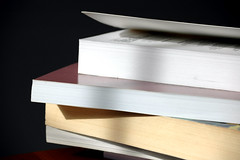 One of our goals for the coming year is to incorporate more literacy practices into science instruction. Some of our teachers are eager to do more of this, while others are more skeptical about taking on this responsibility. As the department chair, I’m looking for some discussion ideas and resources.
One of our goals for the coming year is to incorporate more literacy practices into science instruction. Some of our teachers are eager to do more of this, while others are more skeptical about taking on this responsibility. As the department chair, I’m looking for some discussion ideas and resources.
—Kevin, Chesapeake, Virginia
The topic of literacy and science has been around for as long as I can remember (and was the focus of my master’s research project and several action research projects). These days the topic has taken on a new life with the inclusion of obtaining, evaluating, and communicating information as a Scientific and Engineering Practice within the Next Generation Science Standards (NGSS). Many state standards and local curricula in communications or language arts include four processes: reading, writing, speaking, and listening. Although they were designed for reading and language arts classes, it would be hard to imagine scientists who do not use these processes daily.
I suspect there are those who see the first part of the practice, obtaining, as simply locating information. That’s not a problem with a wealth of sources on the Internet. But are students able to understand what they’re reading when they find it? If they struggle with traditional print resources, they will also struggle with online text. The struggle does not disappear when students use electronic devices. Will students be able to evaluate what they read or will they simply accept whatever they find on the Internet as factual?
Unlike what students might see in a reading or English class, science resources are not usually written as stories or in chronological sequence. Science text often starts with a main concept and then provides descriptions or supporting details. Science text often uses headings, subheadings, abstracts, summaries, sidebars, footnotes, and graphics. Science text uses specialized vocabulary (often highlighted and linked to a glossary) and may be written from an expert point of view. Students may not realize reading science text can be a slower process than reading a novel or story, and rereading a section is appropriate and even encouraged. Many of the reading skills students learn in their other classes can be transferred to science, but students may need some help to make the connections. And who better to help them than their science teachers, who know how to read science materials.
Several Ms. Mentor columns have addressed literacy topics related to reading, vocabulary, and visual literacy:
Science and reading. I have to attend a workshop on teaching reading in the content areas. Is it really the job of a secondary science teacher to teach students how to read?
Comprehending science text. I’m incorporating several strategies this year to help my life science students understand written information. I provided study guides with questions to answer, graphic organizers, and quizzes on the information, but they still don’t seem to comprehend what they read. Do you have any other suggestions?
Science-related nonfiction books. I teach science at the elementary level. I’d like to improve our nonfiction science collection for students to read outside of class or for teachers to use during read-alouds. I want to be sure what we purchase is appropriate; do you have any suggestions or lists of recommended books for this level?
Visual literacy. Our district has a goal for every teacher to reinforce student literacy skills. We’re struggling with this at the secondary level. Most of our students seem to have decent reading levels, and the reading specialists provide extra help for those who need it. So what can we do in science classes to improve student literacy? (See also the Visual literacy collection in the NSTA Learning Center.)
Words, words, and more words. I’d like to change my approach to learning vocabulary. Even when I ask students to write definitions in their own words, they don’t seem to understand the terms. Any suggestions?
Putting science words on the wall. I’ve seen “word walls” in elementary classrooms, but I wonder whether older students would find them helpful in dealing with vocabulary. What should I consider in trying this idea?
 One of our goals for the coming year is to incorporate more literacy practices into science instruction. Some of our teachers are eager to do more of this, while others are more skeptical about taking on this responsibility. As the department chair, I’m looking for some discussion ideas and resources.
One of our goals for the coming year is to incorporate more literacy practices into science instruction. Some of our teachers are eager to do more of this, while others are more skeptical about taking on this responsibility. As the department chair, I’m looking for some discussion ideas and resources.
—Kevin, Chesapeake, Virginia
I'm a New Teacher: How Can NSTA Help Me?
By Carole Hayward
Posted on 2014-06-17

According to the National Commission on Teaching and America’s Future, almost half of America’s new teachers leave the profession within the first five years. Therefore, it is vital that new teachers receive the support necessary to succeed. NSTA provides encouragement to beginning science teachers through programs such as the New Science Teacher Academy.
NSTA member Navneet Riar, a first-year high school biology and chemistry teacher, has discovered first-hand the advantages of being an NSTA member. Since joining right out of college, she has attended two NSTA national conferences and benefited from a number of NSTA resources that have helped her navigate the challenges of being a new teacher.
Riar: My first priority coming out of graduate school was to attend an NSTA conference. I joined NSTA when I was still a student teacher. I applied for a travel scholarship and got it. So, it was much cheaper for me to attend the conference. And, as a student teacher, NSTA had special workshops for new teachers and a meet-and-greet session at the conference. The conference was a really nice introduction to the organization. My first conference was the 2013 NSTA National Conference on Science Education in San Antonio. I also went to the one in Boston this year.
I was still student teaching when I attended the conference in San Antonio, and I wasn’t sure what I was going to end up teaching. Therefore, I attended a bunch of different workshops and sessions; I went to some for high school chemistry and some for biology. I also went to marine education sessions, which is good because I’m teaching marine science this year.
There are so many teachers at the conference and you say to yourself, ‘Wow, all of these people really like teaching.’ It’s a good motivator.
A huge help to me was an article in “The New Teacher Toolbox” section of The Science Teacher journal, titled “Your First Conference.” I followed the article’s suggestions and brought a bag for all of the free stuff handed out in the exhibitor’s area. The advice in the article was super helpful. I find lots of great tips in “The New Teacher Toolbox” column each month.
What other NSTA resources do you use?
Riar: I posted a question on the NSTA Learning Center before I started teaching asking how I should spend my summer getting ready. I received really good advice. Fellow teachers told me to spend time mastering content. That was really good advice, especially since I ended up teaching chemistry my first year, which I had less experience with.
In NSTA Reports and online, there is a freebies section that I regularly look at to see if there is anything I can quickly grab and use. This is especially helpful for new teachers who are looking for low-cost, quick, and easy finds.
I really like being a member of NSTA. Hopefully I can start getting involved more. It’s a great place to network and get to that next level in your career.
Not a member of NSTA? Learn more about how to join.
Jennifer Henderson is our guest blogger for this series. Before launching her freelance career as a writer/editor, Jennifer was Managing Editor of The Science Teacher, NSTA’s peer-reviewed journal for high school science teachers.
From Viruses to Whales, Help Your Students Learn the Common Patterns of Evolution
By Carole Hayward
Posted on 2014-06-16
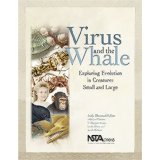 What’s it like to study evolution as a scientist? That’s the question Judy Diamond, with the help of Carl Zimmer, E. Margaret Evans, Linda Allison, and Sarah Disbrow, set out to answer in writing Virus and the Whale: Exploring Evolution in Creatures Small and Large. The book issues an invitation to middle school students to get engaged in hands-on, inquiry-based activities that are based on current research projects—ones that have had a major influence on how today’s scientists think about evolution.
What’s it like to study evolution as a scientist? That’s the question Judy Diamond, with the help of Carl Zimmer, E. Margaret Evans, Linda Allison, and Sarah Disbrow, set out to answer in writing Virus and the Whale: Exploring Evolution in Creatures Small and Large. The book issues an invitation to middle school students to get engaged in hands-on, inquiry-based activities that are based on current research projects—ones that have had a major influence on how today’s scientists think about evolution.
The book is a product of the Explore Evolution project, a joint effort between science museums and 4-H organizations in the Midwest, to bring current research on evolution to middle schoolers and educators as well as the general public. Because the project has produced new permanent exhibit galleries for partner museums who are part of this effort (a full list of which can be found in the book) Virus and the Whale can be used in conjunction with these museum exhibits or as an independent resource.
The unique title of the book was taken from the central theme of the Explore Evolution project: “to show common patterns and principles in the evolution of organisms ranging in size from viruses to whales.” A secondary theme for the book is intended to show how scientific research uncovers new ideas “about how the natural world operates, and how these ideas are continuously modified by new research.”
“As educators, our task is to help young people feel that it means to view the world form a scientific and evolutionary perspective,” Diamond writes in the book’s preface. “This book provides durable, hands-on and easy-to-use activities to bring investigations about evolution to youth in any of the settings where they can do science with their peers.”
Eugenie C. Scott, executive director of the National Science Education Center, Inc., who wrote the introduction to the book, said, “students should know about (evolution) for the sheer intellectual joy of the experience.” Scott’s hope for the educators who read this (be they teachers, youth leaders, or museum curators) is that they can help people “appreciate evolution and how it helps us to makes sense of so much of the living world.”
Designed to encourage social interaction between young people, the book’s activities will work in practically any setting. Each activity begins with a short essay that gives students an overview of a scientist’s research project on a particular organism and is followed up by a four-part, hands-on activity. Students first go through a brief exercise, which introduces them to the organism being studied. This is followed by two sections of investigations, each based on an aspect of the scientist’s research. The two final sections of each activity include an assessment tool where students are asked to think like a science reporter and then summarize their understanding of the chapter’s activities.
Whether it’s a middle school science classroom, a club or an afterschool program, this book’s easy-to-use activities provide the perfect launch pad for making the teaching of evolution interesting and relatable. There’s even some humor thrown in for good measure—something every middle school educator can appreciate!
This book is also available as an e-book.
Q&A about natural spaces for children
By Peggy Ashbrook
Posted on 2014-06-15
 It was a perfect early summer day with temperatures in the low 70s (F) and a gentle breeze that make it easy to be outdoors for hours. We had a combination of shade, sunscreen or hats to protect from the sun’s ultraviolet radiation and a pitcher of water to drink when thirsty. And we had a play space that engaged the children in running after each other, digging and moving sand, climbing in the low trunks of a shrub-y tree, and swinging on the tire swing. It was a perfect day to reflect on what elements make a successful outdoor play space.
It was a perfect early summer day with temperatures in the low 70s (F) and a gentle breeze that make it easy to be outdoors for hours. We had a combination of shade, sunscreen or hats to protect from the sun’s ultraviolet radiation and a pitcher of water to drink when thirsty. And we had a play space that engaged the children in running after each other, digging and moving sand, climbing in the low trunks of a shrub-y tree, and swinging on the tire swing. It was a perfect day to reflect on what elements make a successful outdoor play space.
The preschool program is soon moving to a new location where a play space will be created in an area with some trees bordering a grassy space. What elements should be in place before school begins in September and which elements can be added later, if they seem appropriate once we see how the children and the teachers use the space? How can we choose elements from all the examples of beautiful and creative play spaces we’ve seen that will work best on this land with this preschool program?
Continued research can help, beginning with a book, The Great Outdoors: Advocating for Natural Spaces for Young Children, Revised Edition (2014 NAEYC) by Mary Rivkin. Dr. Rivkin is an associate professor of education at the University of Maryland, Baltimore County. Her research focuses on children’s outdoor play.
Other resources included:
- “Creating and Enriching Quality and Safe Outdoor Environments” by Heather Olsen in Dimensions Extra 41(3) 7-11.
- “Safety First: Ensuring a Safer Outdoor Experience” by Ken Roy in the March 2014 Science and Children.
- “Science and the Outdoor Classroom” by Polly Neill in Extensions May/June 2008, Vol. 22, No. 5
- “The Southern Early Childhood Association’s (SECA) 2013 Exemplary Outdoor Classroom State Winners“
- “Supporting Whole-Child Learning in Nature-Filled Outdoor Classrooms” by Susan Wirth and Nancy Rosenow in the January 2012 Young Children.
- Young Children, January 2008 issue, Teaching and Learning about the Natural World

 Children need an outdoor play space all year round so rainy days and snowy days need to be considered when planning to meet children’s needs. Dr. Rivkin’s examples will inspire me as I advocate for elements to engage children in learning about the natural world—mud kitchens for fully experiencing this earth material, learning about solids and liquids while digging in melting ice and snow, finding one’s center of gravity while balancing on logs and walking among trees and noticing the diversity of leaf shapes.
Children need an outdoor play space all year round so rainy days and snowy days need to be considered when planning to meet children’s needs. Dr. Rivkin’s examples will inspire me as I advocate for elements to engage children in learning about the natural world—mud kitchens for fully experiencing this earth material, learning about solids and liquids while digging in melting ice and snow, finding one’s center of gravity while balancing on logs and walking among trees and noticing the diversity of leaf shapes.
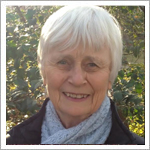 You can ask Dr. Rivkin a question by posting it on the National Association for the Education of Young Children’s (NAEYC) website on the “Q&A with the author of The Great Outdoors” page this week, June 16-20, 2014. I’m going to ask an impossible question:
You can ask Dr. Rivkin a question by posting it on the National Association for the Education of Young Children’s (NAEYC) website on the “Q&A with the author of The Great Outdoors” page this week, June 16-20, 2014. I’m going to ask an impossible question:
If you could only afford one play space element, what would you choose?
Maybe you all have suggestions for me too!
Top 12 Episodes of the Lab Out Loud Podcast
By Carole Hayward
Posted on 2014-06-12

 Wisconsin-based duo Dale Basler and Brian Bartel have been podcasting together for almost 10 years, not only combining their love of science and technology, but also generating the free award-winning Lab Out Loud podcast, which is supported by NSTA and features the best in science education news and commentary.
Wisconsin-based duo Dale Basler and Brian Bartel have been podcasting together for almost 10 years, not only combining their love of science and technology, but also generating the free award-winning Lab Out Loud podcast, which is supported by NSTA and features the best in science education news and commentary.
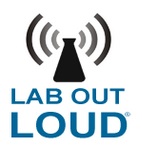 With backgrounds as science teachers and curriculum specialists, Dale and Brian produce two 30-minute episodes per month and focus on science education by interviewing leading scientists, researchers, science writers, and other important figures in the field. Even they are surprised at where the discussion with guests can lead. Recently, they started talking about the future of robots with guest Illah Nourbakhsh (Episode 109), and ended up having insightful conversation about the process of science and educational philosophy.
With backgrounds as science teachers and curriculum specialists, Dale and Brian produce two 30-minute episodes per month and focus on science education by interviewing leading scientists, researchers, science writers, and other important figures in the field. Even they are surprised at where the discussion with guests can lead. Recently, they started talking about the future of robots with guest Illah Nourbakhsh (Episode 109), and ended up having insightful conversation about the process of science and educational philosophy.
“After seven seasons of Lab Out Loud, one thing that keeps us going is the support we receive from our target audience: science teachers,” said Brian. “We know that teachers listen to the show for ideas, inspiration, and some even use our episodes in class. Episode 5: Sir Alec Jeffries and DNA Fingerprinting and Episode 34: Gene Therapy for Colorblind Monkeys are classroom favorites.”
With more than a hundred episodes, podcasts themes have covered everything from Next Generation Science Standards for science teachers, engineering activities for students, and next generation technology upgrades for K-12 classrooms. By distilling diverse subjects of science, from physics to paleontology, into the 30-minute audio format, Dale and Brian aim to give fellow educators inspiration and confidence to continue exploring science outside the classroom.
Dale and Brian’s Top 12 Favorite Episodes:
- Episode 109: Thinking About Our Future with Robots
- Episode 74: There’s a Zombie in My Classroom
- Episode 59 – The Courage to Teach
- Episode 55: Science Comedian Brian Malow
- Episode 49: Science We Can Listen To (They Might Be Giants)
- Episode 46: Paleontologist Scott from Dinosaur Train
- Episode 43: Mythbusters’ Adam Savage
- Episode 37: Science Because We Can (Dr. Theo Gray)
- Episode 34 – Gene Therapy for Color Blind Monkeys
- Episode 32: Neil deGrasse Tyson on Science Literacy
- Episode 14: Bill Nye Talks About Energy and More
- Episode 5: Sir Alec Jeffries and DNA Fingerprinting
“Doing the show has expanded our own knowledge about science beyond our comfort areas,” said Dale. “It has been a way for me to learn about things I would not have normally pursued. And we also get to connect with some of our heroes in science. How many people have been able to call Bill Nye?”
In the time it takes to get to work in the morning, run to the grocery store, or eat lunch, one 30-minute Lab Out Loud podcast can keep you inspired, boost your science knowledge, and maybe even get you inspired to be part of the science education movement.
Subscribe to Lab Out Loud today!
More time?
- Read the Lab Out Loud blog, where the hosts provide insight on episode guests, discuss themes, and provide linked resources from each podcast.
- Dale and Brian actually started podcasting in 2006, for the Wisconsin Society of Science Teachers in a show called Periodicity. You can still find all 52 episodes at http://laboutloud.com/2007/06/periodicity.
Not a member of NSTA? Learn more about how to join.
Laura Berry of Cogberry Creative is our guest blogger for this series. Laura is a communications professional for the education community.
How to Turn Your Schoolyard into a Year-Round Scientific Classroom
By Carole Hayward
Posted on 2014-06-11
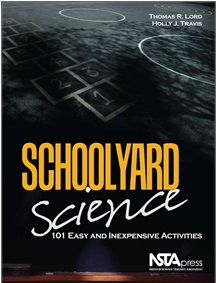 It would take mere seconds for any one of us to explain how technology has improved our everyday lives. Yet there are some downsides to all these “life upgrades.” How many of us spend more time exploring our new smartphone app or game than we do the great outdoors? A more sedentary lifestyle is certainly associated with increased health concerns, especially for children, who, research clearly shows, do not play outside as much as they used to/as much as they need to.
It would take mere seconds for any one of us to explain how technology has improved our everyday lives. Yet there are some downsides to all these “life upgrades.” How many of us spend more time exploring our new smartphone app or game than we do the great outdoors? A more sedentary lifestyle is certainly associated with increased health concerns, especially for children, who, research clearly shows, do not play outside as much as they used to/as much as they need to.
Teachers have the power to help reverse many negative health trends occurring with their students by taking their lessons outside of their bricks and mortar buildings. But two obstacles usually prevent this from happening: dwindling funds and/or inadequate resources.
In Schoolyard Science: 101 Easy and Inexpensive Ideas, authors Thomas R. Lord and Holly J. Travis have created more than 100 activities for pre-K through grade 8 teachers to use the external environment immediately outside the walls of their school buildings for their science lessons.
Each inquiry-based, student-directed activity is noncompetitive and was piloted across classrooms, in youth camp activities, or as part of science education classes in teacher preparation programs. All are specifically intended for teachers who have limited backgrounds in scientific nomenclature. The book’s 11 chapters allow teachers to create teamwork-based outdoor scientific activities and experiences that help students develop their critical thinking and collaborative skills. Read a sample chapter: Schoolyard Gardens and Nature Walks.
According to Lord and Travis, “The intent of this book is for students to develop observation skills and an appreciation for the environment, and for teachers to feel comfortable using natural resources available in the schoolyard.” The authors add that all the activities in the book were developed around “easily obtained and inexpensive materials” and that their most important objective in writing this book was to “keep teachers and students actively learning and spending time outside in the natural world.”
Would you like to incorporate a nature walk into your lesson, plant a garden on school grounds, launch a composting program, or build your own watershed? Maybe you’d like your students to create arts with natural materials, monitor weather in the schoolyard, or make a solar oven. If so, this book is for you and your students.
Happy exploring all the wonders of the scientific world that are occurring right on your schoolyard!
This book is also available as an e-book. Additional resources from NSTA Press on outdoor science include Outdoor Science: A Practical Guide; Inside-Out: Environmental Science in the Classroom and the Field, Grades 3–5; Bringing Outdoor Science In: Thrifty Classroom Lessons; Buzz Into Action: The Insect Curriculum for Grades K–4; and Hop Into Action: The Amphibian Curriculum for Grades K–4.



